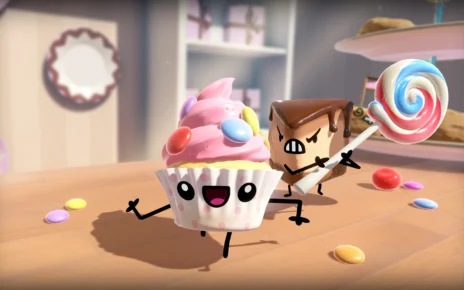The “Mighty Morphin’ Power Rangers” TV show launched when I was barely at the tail end of its target age market. While the rest of my fifth grade classmates and friends quickly dismissed the show in favor of young adult fare, I – having been groomed on other superhuman staples like “X-Men: The Animated Series” and “Teenage Mutant Ninja Turtles” – ate up the embellishments, the costumes, the outrageous weapons, and the explosive (at times, literally) martial arts.
I didn’t realize it at the time, but when I started sketching comic books and designing websites a few years later, the Power Rangers’ flashy aesthetic and cloying camp had subconsciously influenced my own designs. My characters had annoying catch phrases and relied on artifacts as both the source and trigger for their powers, similar to the Rangers’ morphers. I even took a shot at designing my own Power Ranger – this one white, with black diamonds across its chest – and was pleasantly stunned to turn the program on one day see that an actual White Ranger had become part of the canon.
The show’s high episode count, character turnover, and frequent paradigm shifts make it feel like I watched the show for years, but I think my interest waned after a little less than two seasons. At that age, it’s hard to be a superfan of something your other friends are actively scorning, and my family had a bizarre (and unintentional) habit of scheduling vacations on top of the show’s big multi-episode setpieces, including the aforementioned White Ranger introduction. Like Teenage Mutant Ninja Turtles, I have a tiny nostalgia bug that buzzes occasionally – like when the trailer for the new Power Rangers movie debuted a few years back – but unlike the Ninja Turtles, I never bothered to investigate what had happened to the colorful heroes since their heyday.

This has been a very long-winded way of saying that kicking off 2023 by playing through Power Rangers: Battle for the Grid – a budget, licensed multi-platform game based on a TV show that’s maligned by adults as being a mass-produced toy commercial – isn’t as out of left field as it sounds. As the first piece of Power Rangers media I’ve consumed in the better part of thirty years, the game’s modern mobile-first annoyances are occasionally outshined by some bright spots and enjoyable gameplay.
As is the style of the time with generation-spanning franchises, Battle for the Grid is a “multiverse” title that crosses-over characters from all the various incarnations of the Power Rangers franchise – the original Mighty Morphin’ Power Rangers; the “Cenozoic” Power Rangers of the 2017 film; and the multitude of animal, card suit, elemental, mechanical, ninja, etc. rangers from the various TV series in-between – into a single chaotic fighting game. The game itself most closely resembles Marvel vs. Capcom 3 in both setup and energy, with two teams of three attempting to submit each other with dramatic super moves, temporary assists, and – because it wouldn’t be Power Rangers without kaiju – disruptive giant robot attacks.
Mechanically, however, Battle for the Grid is closer to Super Smash Bros. in its simplicity. Players have four attack buttons, but rather than traditional special move inputs, each button + direction combination yields its own independent, predictable attack. The challenge is less about mechanically entering the right combination of commands and more about stringing a bunch of easy-to-execute attacks together to gain an edge, and figuring out which moves can initiate and continue devastating combos.
The game’s main campaign wastes no time making this clear. Not ten seconds into my first battle, my opponent – the Mighty Morphin’ Pink Ranger, one-time crush of pre-teen boys everywhere – unleashed a 19-hit combo that cleared half my health bar, bouncing me against the floor and the wall until she… got bored, I guess? This seemed to be the general formula for battle throughout the game, unless I stuck to a repetitive pattern:
Wait for an opening (or create one). Unleash as much of a combo as my paltry old man fingers can muster. Back away to avoid recovery attacks. Repeat until one of us is defeated.
Missing one of the above steps means punishment in the form of another epic elephant-killing combo attack with little means of escape. Assists and kaiju attacks are normally good disruptors for an aggressive opponent, but neither of them – including the teasingly-named “Counter” kaiju attack – can be executed until your character is in a neutral stance, i.e. not being attacked or attacking. Occasionally, some manner of thrashing, button mashing, and opponent pity might result in my player backflipping to regain control, but more often than not, an opponent that starts a brutal combo will take out the better part of my health bar before arbitrarily letting up.

When not locked into an endless, inescapable combo, the game’s fights are fairly entertaining. Attacks feel strong, special moves are flashy, and the tag mechanics – though slightly more awkward than Capcom’s own implementation – make for a solid albeit simple experience. The game’s Story Mode tries to inject some variety into the experience by changing up your player team and your alignment across three acts and multiple chapters. Think Mortal Kombat vs. DC Universe, except your alignment can switch multiple times in a single chapter. It’s extremely disorienting to begin a battle as a team of three Power Rangers taking on a big bad like Goldar, only to win the match and play the next as… Goldar himself. Whose side am I on, exactly?
Aside from the Story Mode, the expected assortment of bedrock fighter modes is here: Arcade (3v3 + Kaiju fights leading up to a boss), Versus (quick match), Online, and Training. Arcade Mode plays similarly to Story Mode, except the AI opponents seem to maintain a higher intensity from the start of the ladder. The game’s starting roster is small, but if your Power Rangers heritage began in the Mighty Morphin’ days, it includes enough tentpole characters to get you started, including various flavors of personal favorite Tommy Oliver. (R.I.P. Jason David Frank) Because of Stadia’s sunset status, I wasn’t able to explore the extended roster or the costumes it unlocks, though it’s worth noting that Street Fighter’s Ryu and Chun Li make surprise appearances as guest rangers. Maybe the developers are taking a page from Hollywood and casting high-profile fighters to elevate the status of their own.
The game audio aims to serve the fans. A handful of the TV show’s original voice actors lend their talents here, and the facsimiles sound decent enough. There’s still a lot of ham and cheese in the dialogue delivery – it wouldn’t be Power Rangers otherwise – but it gets the job done, and the game smartly reverts to speech bubbles for most of the exposition anyway. The musicwill likely make longtime fans happy, as the composer makes liberal use of the “Go, Go, Power Rangers!” leitmotif, but the songs themselves mostly fade into the background behind the battle chaos anyway. Though I didn’t get to hear it in game, I was pleased to hear the main track for the crossover during my post-game ritual of listening to a game’s full soundtrack, which mashes up the old school Power Rangers theme with the original Street Fighter character themes.
Power Rangers: Battle for the Grid was an entertaining romp at its budget price point or as part of a subscription offering, especially for someone with long dormant Power Rangers roots, but it doesn’t really have the legs of a full fat fighter, and the fight mechanics – which hand out brutal, excessive punishment the moment you let your guard down – get in the way of what the game does well. Though I can’t imagine playing this without a gamepad, everything is clearly built with a “premium mobile” attitude – clean but basic graphics, a modest presentation, and a roster that starts out paltry but grows to surprising heights once you start purchasing DLC. I don’t think I’m going to be diving back into the Power Rangers universe after dabbling here, unlike the Lazarus effect that Teenage Mutant Ninja Turtles: Shredder’s Revenge had on that franchise, but I could easily see myself playing a quick round or two of this in the future on Steam, once Stadia version disappears.
At least, until I get sick of getting kicked in the face.





